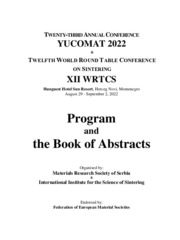Приказ основних података о документу
Study of oil type pollutant adsorption on Vrbas River sediments (Bosnia and Herecgovina)
| dc.creator | Pržulj, Sanja | |
| dc.creator | Veselinović, Gorica | |
| dc.creator | Ivanišević, Marko | |
| dc.creator | Gnjato, Slobodan | |
| dc.creator | Balaban, Milica | |
| dc.creator | Jovančićević, Branimir | |
| dc.date.accessioned | 2023-06-04T14:48:57Z | |
| dc.date.available | 2023-06-04T14:48:57Z | |
| dc.date.issued | 2022 | |
| dc.identifier.isbn | 978-86-919111-7-1 | |
| dc.identifier.uri | https://cer.ihtm.bg.ac.rs/handle/123456789/6205 | |
| dc.description.abstract | PAHs are a group of ubiquitous persistent organic pollutants that cause sever global environmental concerns for ecosystems and human health due to their potential toxicity and carcinogenicity. PAHs are a group of organic pollutants strongly related to anthropogenic activities such as settlement, transport, and industrial development. Due to their lipophilicity and persistence, PAHs are readily adsorbed in the particulate matter once they enter the urban river system and are finally deposited in the sediment. [1] The aim of this work was to evaluate the distribution of PAHs in the sediments of Vrbas River, to assess their occurrence and to establish the origin (pyrogenic/petrogenic) of pollution sources.This study focussed on investigation on the state of pollution and identification of potential sources of contamination of river sediments by polycyclic aromatic hydrocarbons along entire course of the Vrbas River (Bosnia and Herzegovina). Nineteen sampling points were selected covering the entire course of the Vrbas River (Bosnia and Herzegovina). The samples were extracted in a Soxhlet apparatus and fractionated using column chromatography. In the fraction of aromatic hydrocarbons, PAHs were analysed by gas chromatography - mass spectrometry (GC-MS) in a selected ion monitoring (SIM) mode. The ions monitored were: m/z = 128 (naphthalene), m/z = 152 (acenaphthylene), m/z = 154 acenaphthene), m/z = 166 (fluorene), m/z = 178 (phenanthrene andanthracene), m/z = 202 (fluoranthene and pyrene), m/z = 228 (benzo[a]anthracene and chrysene), m/z = 252 (benzo[b]fluoranthene, benzo[k]fluoranthene, benzo[j]fluoranthene, benzo[e]pyrene and benzo[a]pyrene), m/z = 276 (indeno[1,2,3-c,d]pyrene and benzo[g,h,i]perylene), and m/z = 278 (dibenzo[a,h]anthracene) [2]. Thereafter numerous PAH diagnostic ratios were calculated and analysed. High molecular weight polycyclic aromatic hydrocarbons (4, 5 or 6 rings) are more prevalent in the observed samples. The analysis of different PAH diagnostic ratios indicate the pyrogenic PAHs origin. In most samples, according to calculated parameters, these are combustion products of coal, grass, and wood, while in some samples these parameters implicate the fuel combustion origin of PAHs. No regularity was observed in the distribution of PAHs in the samples, indicating the existence of multiple sources of these compounds in the investigated area. Thus, the conclusion is that this area was exposed to both point and diffuse sources of PAH contaminants. | sr |
| dc.language.iso | en | sr |
| dc.publisher | Belgrade : Materials Research Society of Serbia | sr |
| dc.rights | openAccess | sr |
| dc.rights.uri | https://creativecommons.org/licenses/by-nc-nd/4.0/ | |
| dc.source | Program and the Book of Abstracts - 23rd Annual Conference YUCOMAT 2022 & 12th World Round Table Conference on Sintering WRTCS 2022, August 29 - September 2, 2022, Herceg Novi, Montenegro | sr |
| dc.subject | PAH | sr |
| dc.subject | persistent organic pollutants | sr |
| dc.title | Study of oil type pollutant adsorption on Vrbas River sediments (Bosnia and Herecgovina) | sr |
| dc.type | conferenceObject | sr |
| dc.rights.license | BY-NC-ND | sr |
| dc.citation.spage | 141 | |
| dc.citation.epage | 141 | |
| dc.description.other | [https://www.mrs-serbia.org.rs/index.php/yucomat-books-of-abstracts/yucomat-wrtcs-202] | sr |
| dc.identifier.rcub | https://hdl.handle.net/21.15107/rcub_cer_6205 | |
| dc.identifier.fulltext | http://cer.ihtm.bg.ac.rs/bitstream/id/25608/YUCOMAT_2022-XII_WRTCS-veselinovic.pdf | |
| dc.type.version | publishedVersion | sr |


